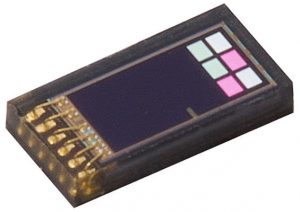
“While the UV-C portion of sunlight is blocked by the earth’s atmosphere, UV-A and UV-B radiation
reaches the earth’s surface,” according to the company. “UV-B radiation penetrates only the upper layers of the skin and is responsible for sunburn. UV-A radiation, which accounts for around 90% of the UV component that reaches the earth’s surface, penetrates much deeper into the lower layers of the skin and can, in some cases, have significant health consequences – from weakening of the connective tissue to faster aging of the skin and a higher probability to develop skin cancer.”
Called TSL2585, the 1 x 2 x 0.35mm detector uses interference filters deposited on a photo-diode array to create a human-eye response photopic channel and an infra-red channel alongside the 315-400nm UVA channel. The sensitive area is located at one end of the package to allow it to be used in products with bezels as narrow as 0.4mm.
“High sensitivity enables reliable detection of ambient
light even when placed under low transmissivity materials and OLED displays,” said Osram marketing manager Barry Guo.
Light flicker detection is built in to provide information for phone cameras – allowing banding effects caused artificial lighting to be avoided.
It will run from 1.7 – 2.0V, and connects to the world though a 1.8V I2C interface. Consumption is 700nA at 1.8V,
The TSL2585 product page is here (data sheet has to be requested)